Ten Thousand Swans
A hard rain pelted the tin roof and thunder rattled the windows. Lightning strobed across the Scuppernong River. It was January, four o’clock in the morning, and unseasonably warm, even for eastern North Carolina. The Riverview Lodge, a facility built in the 1920s and now owned by a nonprofit school of fine hand crafts, was hosting a group of twenty nature enthusiasts. In two hours, we would set out to witness the annual visitation of tundra swans in the Pocosin Lakes National Wildlife Refuge.
I was nervous. I would be driving the majority of the guests in an enormous rental van on unpaved roads to Pungo Lake—a shallow, egg-shaped body of black water. Legend suggests that Pungo was the result of an ancient meteor shower that also carved out several other remarkably shallow and rounded bodies of water in these parts. More likely the cause was ground fires that burned craters in the peat-rich soil. The 2,800-acre depression that is Pungo then filled up with rainwater.
Tom Earnhardt, our guide for this expedition, had told us earlier that night over a supper of steamed oysters and boiled shrimp that we were certain to see thousands of white swans at Pungo, along with an assortment of migratory ducks, snow geese, red wing blackbirds, and possibly a bear or two. (There are more bears than people in Tyrrell County where we were spending the night.)
“If you look at Google Earth’s night view of the Western Hemisphere, you’ll see why the birds come to this spot in North Carolina,” Tom said. “The Pocosin Lakes area is probably the largest expanse of true darkness remaining on the east coast of the U.S.”
Earnhardt—author, naturalist, and host of the statewide public television show, “Exploring North Carolina”—was prominent among the many conservationists, national environmental organizations, and feisty local farmers who opposed a scheme by the U.S. Navy to establish an air field here. The plan had called for a dark site where novice pilots could practice jet takeoffs and landings around the clock—all within three-and-a-half miles of the Pocosin Refuge. The birds and planes would be a mutual hazard, opponents argued, and following years of dispute, the navy finally surrendered. Despite the national publicity surrounding the annual presence of the magnificent birds that were threatened by the proposed airfield, human visitors to the refuge are still mercifully sparse.
***
It was an hour’s drive to Pungo Lake from where we’d spent the night, and we drove through several stretches of blinding rain before the front finally moved on and colder air descended. On first inspection, this part of North Carolina’s coastal plain seems terribly desolate, especially in winter. Corporate agriculture dominates the long vistas from the main highway where turkey houses and catfish ponds often separate one enormous field from the next. Sometimes a bald eagle or two will be keeping watch on the banks of these ponds for an easy catfish meal. In January, the farm equipment is mostly silent. Winter wheat, soybeans, cotton, and sweet potatoes are the rotating crops through the year.
Wild turkey, deer, coyote, and rabbit are plentiful year-round and hide out in the thick scrub along the rivers that lace the landscape. Here is where the scuppernong, a hard-hulled native grape, also gave its name to the narrow river that meanders north of the Pocosin Refuge and widens as it turns toward the much larger Albemarle Sound. More than a decade ago, the endangered red cockaded woodpecker and red wolf were reintroduced in this region in hopes of rolling back their near extinction.
For their part, the tundra swans navigate their flight from Siberia, Alaska, and northern Canada all the way down the east coast of North America. They arrive here after the full moon in November and stay for three more moons until late February or early March. They feed and preen in the shallow waters and spongey fields, and the yearlings among them begin the process of scouting a lifetime mate. The swans don’t commence breeding, however, until they are back home at the top of the world. It’s a round-trip journey of some 3,700 miles.
***
Once we reach the gates to the refuge, no one dares take a last sip of cooling coffee from the paper cups we’ve provided. The ride is rough. Within minutes the vehicle is a Jackson Pollock canvas of sand, slime, and mud. The van waddles over rugged berms and bumps through pitch black puddles of uncertain depth. There is no turn-around for miles, and the van windows fog with our body heat. We are flanked on either side of the vehicle by menacing ditches and impossibly dense scrub. We bounce and lurch forward. The passengers on the third and fourth benches in the back issue inadvertent groans as they are lifted up and dropped back down on their hard seat cushions.
Tom Earnhardt had warned me first thing that morning to keep up my speed and stay a good distance behind his lead vehicle. The heavy van would require consistent forward momentum to avoid lapsing into the muck, tires spinning. Tom was stuck out here once, he said, with no cell phone signal and no tow rope.
I kept glancing at my passengers in the rearview mirror as they clung to the binoculars and cameras around their necks to avoid a flying smack to the chin from the gear.
***
According to National Geographic data, a Tundra Swan can weigh between eight and 23 pounds. It has a wingspan of five-and-a-half feet. It can live up to 20 years in the wild, but the average life span is probably closer to 10 or 12 years, according to Tom Earnhardt. Tundra swans are omnivorous, feeding on plants and bivalves in the waters and on agricultural grains ready for harvest in the fields or already spilled from thrashing. Tom told us that farmers who are allowed to plant crops in the refuge must expect to lose about 20 percent of their crop to the feathered tourists, but they are so awed by the sight of their arrival, they do not fret. The swans and snow geese are a sign of nature’s health, and there are simply too many to try and chase away.
The refuge is an oblique maze of roads, mostly unmarked, threading through 111,000 acres of pond pines, gums, cypress, cedar, and evergreen shrubs. Suddenly on a dry stretch of road beside a field to our left, Tom’s taillights come on. He stops his SUV. Multiple flocks of starlings mixed with redwing blackbirds have just shot up from a thicket of trees on the opposite side of the road like exploding fireworks.
They begin twisting into dark ribbons, by turns wide and narrow, a Mobius strip against the cloud cover. I roll down the window for a better view. The volume of their shrill cacophony proves the number of birds we are seeing—easily a thousand or more, now breaking into separate bands of geometric shapes.
The image reminds me of a toy I had as a child: a magnetic pencil attached by string to a plastic bubble-covered outline of a bald man’s face. Under the plastic, a mound of black, iron filings could be dragged with the pencil to create hair and whiskers—mustache, sideburns, and beard—on the man’s face. Then you could shake the filings loose and start over.
These starlings seem magnetized by some invisible pencil as they draw themselves across the sky and finally land in the far field. Their frenetic flight stirs us with anticipation. Their pure white migration mates are surely up ahead.
***
The trip to a destination the first time always seems longer in the going than in the return, and so it is with this trip. When we finally come upon a sign for the Pungo Lake Observation Platform and Charles Kuralt Trail Site, we are giddy. The famous journalist loved this area of his home state, and a series of trails trace his travels and commemorate his stories of the region.
Because of the wind direction, Tom Earnhardt knows we will see birds on this side of the lake today. From a distance they come into view as white strokes on the grayish water that is reflecting the still lightening sky. We park near the observation deck and clamber out of the van. Tom tells us there are maybe ten to fifteen thousand swans in the area as we climb the stairs to the observation deck. People begin setting up tripods for cameras and scopes. The wind is cold, and the swans’ honking is palpable—a musical note that author and naturalist Rachel Carson once described as “a sound that suggests a woodwind instrument in its quality.” If so, this is the biggest woodwind section I have ever heard, all at once warming up, getting their reeds good and wet and ready for the conductor to arrive.
Carson—the author of the landmark book Silent Spring (1961)—successfully challenged the use of DDT as a pesticide and earned many literary and environmental awards. Much earlier in her career as a naturalist, however, she wrote a series of pamphlets about the National Wildlife Refuge System, including a booklet published in 1947 about nearby Lake Mattamuskeet, based on a visit to this unparalleled landscape that she never forgot. “At intervals,” Carson wrote of the winter visitation of swans and geese here, “the sound swells as though a sudden excitement had passed through the flock, and at each such increase in the sound a little party of birds takes off from the main flock and moves away to some favored feeding ground.”
I watch a pair of swans take flight, imagining what strength it must take to lift a twenty-pound body of wet feathers free of the numbing water. The swans actually peddle with their feet as if riding a bicycle as they rise. Then, for a moment, it looks as if they are walking on water, their wide wings pumping gracefully. Once in the air, their necks are straight shafts and their bodies seem smaller. When they land, they resemble barefoot water skiers, their webbed feet literally serving as brakes, stirring a white wake behind them.
Through binoculars I can pick out a few young cygnets, as they are called. Their feathers are light gray, not yet the brilliant white of their elders, the color providing a protective camouflage I suppose. If we stayed until sunset, Tom tells us, the mature white birds would take on the pinkish cast of the sky.
Photos by Betsy Bennett
***
We drive to several more viewing sites. At one, we are much closer to the swans because the road runs right beside the water. Seeing them to scale against the cattails, the turtles perched on logs, and the cypress knees creates an even greater appreciation for their size and elegance. At another stop, we watch snow geese and swans feeding in a field, their main daytime preoccupation. We stop for our picnic lunch at a spot known as a crossroads for bear, but we only find their tell-tale scat, full of corn and cobs from the nearby fields.
Finally, as the skies begin to clear, the V-shaped flocks that are moving from land to water and back are set off by a deep blue above them. The group in the van talks about wanting to come back. Could it be a two-day excursion next time so that we can see the sunset reflected on the birds? They want to bring friends. Someone declares it is a bucket list item you don’t just check off and are done with—seeing the swans is as unforgettable and magnetic as the swans’ mysterious navigation abilities.
That morning, before we had set out, as we were filling our coffee cups and making sandwiches for our picnic in the refuge, Tom Earnhardt reminded us that the former U.S. poet laureate Mary Oliver had passed away only the week before. He quoted a few lines from her poem “Sometimes”:
Instructions for living a life:
Pay attention.
Be astonished.
Tell about it.
All of us looked forward to completing the assignment as we headed home, wind-whipped and forever astonished.


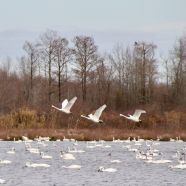





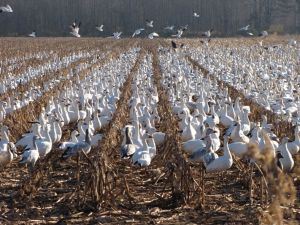

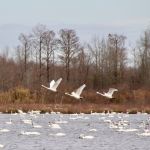
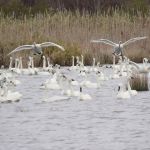
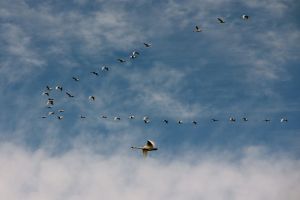
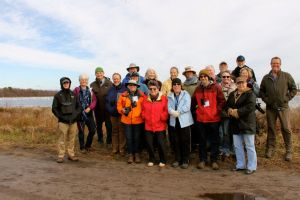
I was right there with you! And the Mary Oliver quote is right on.
Outstanding!
The wrting: simply the best.
Discovering Pungo was a religious experience. I stayed in a guest house called Peace on the Pungo. In the darkness it was impossible to get any sense of my surroundings but at first light there I was right smack dab at the water’s edge. A day awestruck by the beauty and magnificence of the Tundra Swans and all their Cousins was enough to have me ready to return next February. My sincerest thanks to Susan Campbell for posting such a fine photo of the swans thus introducing me to the wonders if the Pungo. Thanks to GE for so elegantly describing this sacred place.
And you’re doing it again next year, Georgann? Put me on your email list!
An unforgettable experience. Although a second visit is unlikely to produce the magic of the first sighting, I’d go again if given the opportunity. Thanks, Georgann and Tom, for a fabulous outing.
It was an unforgettable experience, Indeed! And how wonderful to have this lyrical and informative narrative, with photos, to remind us of that special weekend. Thank you, Tom and Georgann, for planning, leading, sharing and keeping us safe. Kudos to the photographers as well —
Thanks, Georgann, for sharing our adventure. And thanks to you readers for responding. Honk if you want to go with us next year. We’ll put you on the mailing list.
Write to dcminnow@gmail.com
Sounds wonderful. Thanks for telling us about it, and so beautifully.
What an excellent read! Thank you, Georgann!
I’m so happy to know someone who can write so beautifully about an outing in nature!